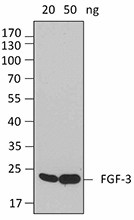- Clone
- W15075A (See other available formats)
- Regulatory Status
- RUO
- Other Names
- INT2, INT-2, Heparin-binding growth factor 3, HNGF-3, HNGF3, FGF3
- Isotype
- Rat IgG2a, κ
- Ave. Rating
- Submit a Review
- Product Citations
- publications

-

20 or 50 ng of human FGF-3 recombinant protein was resolved by electrophoresis, transferred to nitrocellulose, and probed with purified monoclonal anti-human FGF-3 (clone W15075A) antibody. Proteins were visualized using an HRP Goat anti-rat IgG antibody and chemiluminescence detection.
| Cat # | Size | Price | Quantity Check Availability | Save | ||
|---|---|---|---|---|---|---|
| 685102 | 100 µg | $241 | ||||
FGF-3 is a member of the fibroblast growth factor family. The amplification of the FGF-3 gene has been found in many cancer types including squamous cell carcinoma, epithelial ovarian tumors, breast cancer and bladder cancer. FGF-3 is also associated with tumor metastasis and recurrence in human hepatocellular carcinoma. Like many other FGF proteins, FGF-3 plays an important role in embryonic development. FGF-3 is needed for normal inner ear development including placode induction, maintenance, and otic vesicle formation. The role of FGF-3 in ear development is conserved amongst different vertebrates including mouse, chicken, and zebrafish. In addition to FGF-3, it has been shown that FGF-8 and FGF-10 play redundant and unique roles in ear development as well. FGF-3 is also important for early hindbrain patterning. FGF-3 is derived from hindbrain boundary cells and regulates the expression of multiple markers at hindbrain boundaries. It has been reported that FGF-3 is involved in cardiovascular development in two forms. These two forms of FGF-3 are a secreted form that induces proliferation and another form that localizes in the nucleus and inhibits cell proliferation. The nuclear isoform binds rpS2 and this binding has been suggested to interfere with ribosomal biogenesis.
Product DetailsProduct Details
- Verified Reactivity
- Human
- Antibody Type
- Monoclonal
- Host Species
- Rat
- Immunogen
- Human FGF-3 recombinant protein (28-212 a.a.) expressed in E.coli.
- Formulation
- Phosphate-buffered solution, pH 7.2, containing 0.09% sodium azide.
- Preparation
- The antibody was purified by affinity chromatography.
- Concentration
- 0.5 mg/ml
- Storage & Handling
- The antibody solution should be stored undiluted between 2°C and 8°C.
- Application
-
WB - Quality tested
- Recommended Usage
-
Each lot of this antibody is quality control tested by Western blotting. For Western blotting, the suggested use of this reagent is 0.5 - 2.0 µg/ml. It is recommended that the reagent be titrated for optimal performance for each application.
- RRID
-
AB_2616756 (BioLegend Cat. No. 685102)
Antigen Details
- Structure
- 192 amino acids with a predicted molecular weight of 22 kD. Belongs to the fibroblast growth factor family.
- Distribution
- Secreted.
- Function
- FGF-3 plays important roles in embryonic development, cell proliferation, and differentiation. Retinoic acid regulates the signal transduction of FGF-3 in the inner ear development.
- Interaction
- Ribosomal protein S2.
- Ligand/Receptor
- FGF-3 binds to the IIIb isoforms of FGFR1 and FGFR2 with high affinity and binds to the IIIc isoforms of FGFR2 with low affinity.
- Biology Area
- Cell Biology, Neuroscience, Synaptic Biology
- Molecular Family
- Cytokines/Chemokines, Growth Factors
- Antigen References
-
1. Kiefer P, et al. 1991. Mol. Cell Biol. 11:5929.
2. Brookes S, et al. 1989. Oncogene 4:429.
3. Zelarayan LC, et al. 2007. Dev. Biol. 308:379.
4. Fekete DM. 2000. Trends Neurosci. 23:332.
5. Leger S, Brand M. 2002. Mech. Dev. 119:91.
6. Weisinger K, et al. 2012. Biol. Open 1:67.
7. Hatch EP, et al. 2007. Development 134:3615.
8. Antoine M, et al. 2005. Biochem. Biophys. Res. Commun. 338:1248.
9. Frenz DA, et al. 2010. Am. J. Med. Genet. A. 152A:2947. - Gene ID
- 2248 View all products for this Gene ID
- UniProt
- View information about FGF-3 on UniProt.org
Related Pages & Pathways
Pages
Related FAQs
Other Formats
View All FGF-3 Reagents Request Custom Conjugation| Description | Clone | Applications |
|---|---|---|
| Purified anti-FGF-3 | W15075A | WB |
Compare Data Across All Formats
This data display is provided for general comparisons between formats.
Your actual data may vary due to variations in samples, target cells, instruments and their settings, staining conditions, and other factors.
If you need assistance with selecting the best format contact our expert technical support team.
-
Purified anti-FGF-3

20 or 50 ng of human FGF-3 recombinant protein was resolved ...
 Login/Register
Login/Register 







Follow Us